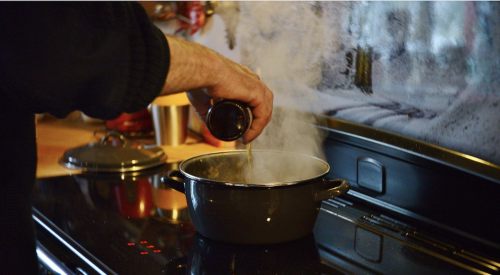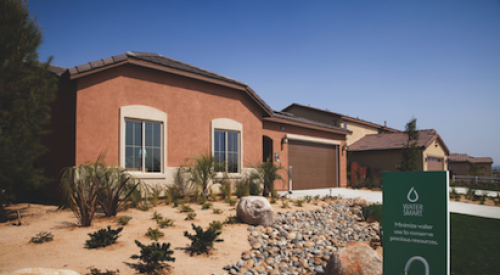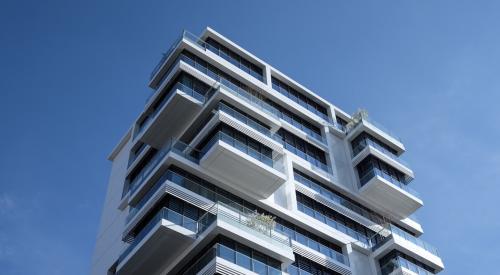|
|
|
|
|
Hedgewood continually experiments to find the products that help the company build the best homes. In Centennial, both blown-in cellulose insulation and Icynene are being tested for energy efficiency and total cost.
In 1998 the NAHB Research Center and the Greater Atlanta Home Builders Association assembled a team to create a template for green building programs for HBAs across the country.
Pam Sessions chaired that committee of builders, architects, building scientists, Realtors and others. The result was EarthCraft House, a voluntary green building program that serves as a blueprint for healthy, comfortable homes that reduce utility bills and protect the environment.
The committee chair was so passionate about the program that Hedgewood Properties volunteered to be the EarthCraft guinea pig. The company built seven pilot homes in early 1999 to help refine the program.
"As a builder, we wanted to make sure this was going to be a viable program, something builders could embrace, not something that would just sit on the shelf," Sessions says. "We tried different aspects of the program on each house, experimenting with different ways of accruing the points. And even though we tried some things that we decided later were not really feasible or were not the best approach, it was the constant learning and evolution of the idea that was so exciting."
The program was introduced to Atlanta builders in September 1999, and in January 2000 Hedgewood became the first builder to commit to building all its homes to the EarthCraft standard. It is still the largest all-EarthCraft builder in Atlanta, and the program is catching on. As of April, more than 80 builders were actively participating.
EarthCraft works on a point system, requiring builders to accumulate 150 points in the following areas: site planning; energy-efficient building envelope and systems (75-point minimum); energy-efficient lighting and appliances; resource-efficient design and building materials; waste management; indoor air quality; water conservation (inside and outside the home); home buyer education; and builder operations (committing to building 80% EarthCraft homes, providing environmental checklists to subcontractors and so on).
|
Hedgewood's Green Road
Sessions tends to think of housing as art, and green building even more so, for its durability and sustainability. "Green is art because it is enduring," she says.
Sessions is not the only person at Hedgewood who's fanatical about green building - everyone is. But going green was not always an easy road to travel. Along with the successes, it was paved with failure, frustration and lack of buy-in from trades. Furthermore, there was a gap in buyers' understanding of a green-built home's benefits.
"We were on the cutting edge," says Pat Kurek, director of construction at Hedgewood's Vickery community and one of the most vocal spokesmen of the Hedgewood/EarthCraft experience. "We were specing in things with no idea what the result would be until the blower door test."
He cites the struggle to get ducts in conditioned space as indicative of the change in mind-set that committing to EarthCraft and sustainable building required. Hedgewood got stuck trying to do it on every home, but sometimes it just wasn't feasible, didn't make economic sense or compromised the home's design too much to make it worthwhile.
"We couldn't force ducts in conditioned space 100% of the time," says Kurek. "We were giving up closets and storage space. Try getting buyers to accept that." Sometimes, especially with existing plans, the solution was to keep the ducts in the attic, insulate the attic more and make up building envelope points elsewhere - EarthCraft allows for such flexibility.
Working with subs who were as unfamiliar as Hedgewood with the new building techniques and materials was another issue, but that quickly turned into a benefit. As the company and the subs learned together, the subs acquired skill sets they could market to the growing number of Atlanta builders interested in green building.
Educating buyers was, and still is, a challenge. Hedgewood capitalizes on documented energy-efficiency savings as the first marketing push, including side-by-side comparisons of the same model using conventional construction and EarthCraft construction in take-home marketing materials and posters inside model homes. From there Hedgewood move on to water conservation, durability, indoor air quality and resource efficiency.
An unexpected bonus was the effect that increased indoor air quality had on buyers. A homeowner in the Longleaf community even wrote a testimonial on how her family's asthma and allergy problems had improved.
"We have gotten as much positive feedback for the indoor air quality aspect," Sessions says. "It's a topic of interest to most in Atlanta because we have so many pollens and allergens, a great percentage of kids have asthma or other respiratory problems."
Continuing R&D
Hedgewood's dedication to finding the most effective, appropriate and economical green building solutions continues. The torch is carried largely by the teams in each community.
Kurek employs waste-reduction and recycling techniques in all his communities. By grinding up gypsum and wood rather than throwing it away, he not only reduced tipping fees, he also reuses the materials as (free) soil amendment and erosion control. He also is toying with rainwater recovery for irrigation in Vickery, Hedgewood's latest community.
In Centennial, Hedgewood is experimenting with Icynene, a liquid foam insulation that expands and dries within seconds to fill and seal the stud cavity. It's more expensive than other insulation options, but Hedgewood is exploring its true cost, including what might be saved in sealing expenses.
With help from building scientists, manufacturers, architects and others, Hedgewood is building the home as a system and managing how improvements in one area affect another. Tighter, better-sealed houses, for instance, allow for less air-conditioning tonnage and heating. At the same time, stopping leaks means that contaminants, stale air and moisture cannot escape as readily, so ventilation is key.
It's that kind of thinking that has made Hedgewood so successful with EarthCraft. Although Hedgewood has not analyzed how green building directly affects the bottom line, Kurek says he sees a boost in sales to people for whom sustainability is important.











